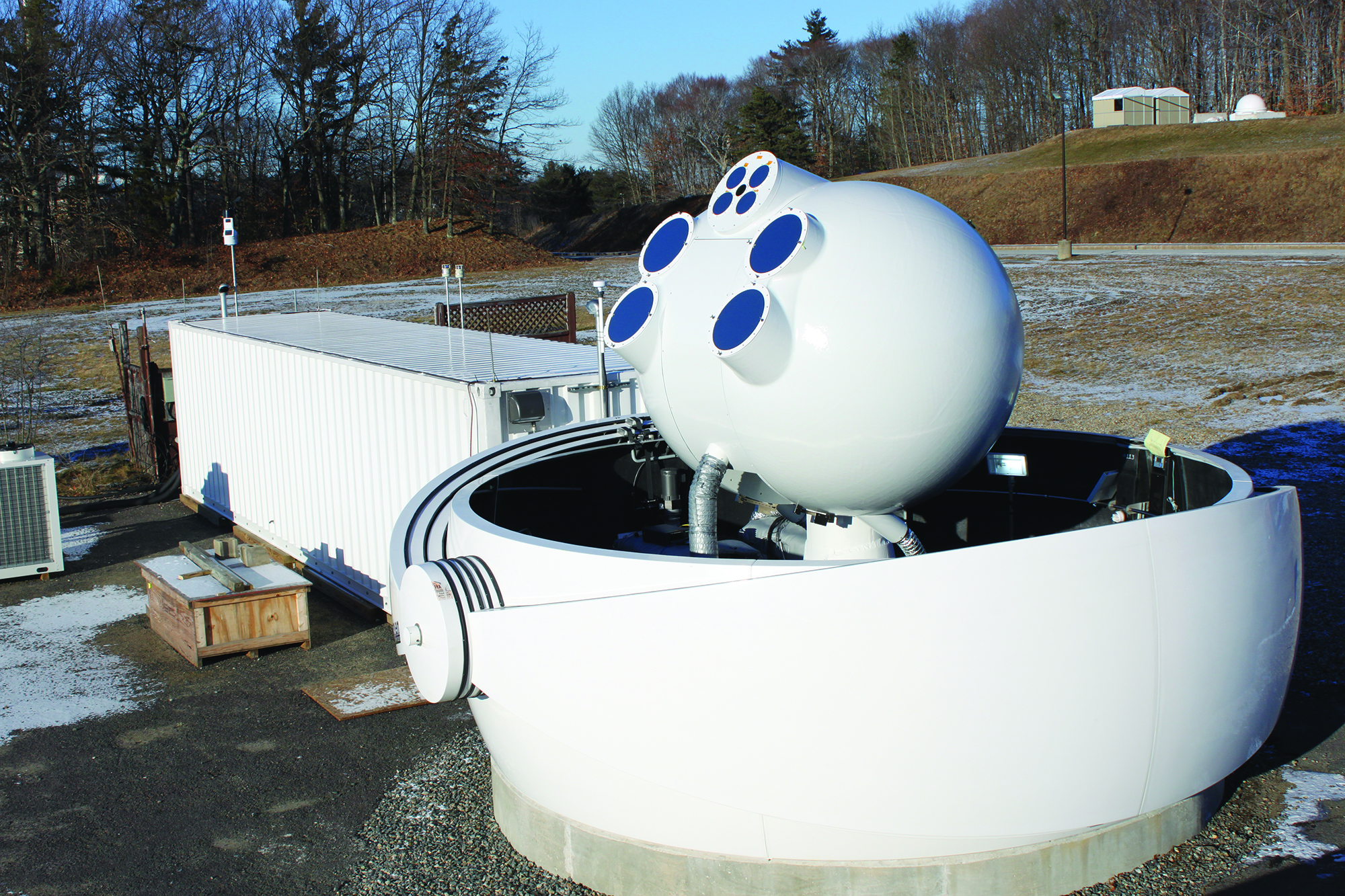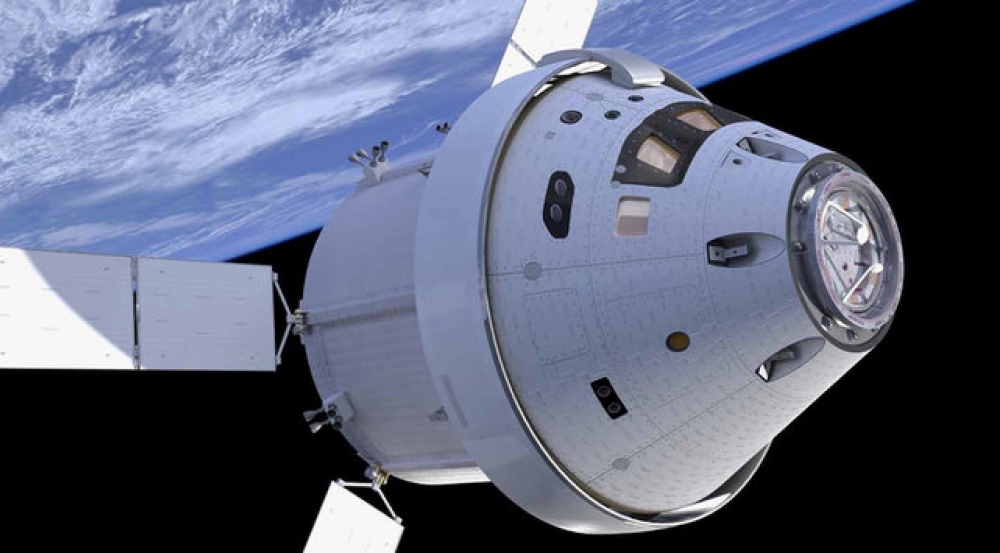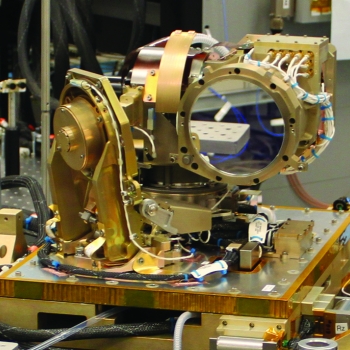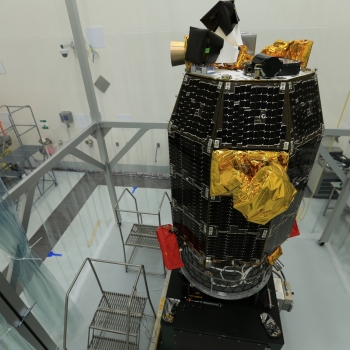
Lighting up the speed of communications
On October 17, 2013, a team of NASA scientists and researchers from Lincoln Laboratory made history by transmitting video data from a satellite orbiting the Moon to a ground station in New Mexico at a rate of 622 megabits per second (Mbps). This data transfer reaching down 239,000 miles realized a data rate six times higher than any transmission achieved by any previous radio system flown to the Moon. Then, the team uploaded data from the New Mexico ground terminal to the space terminal at a rate of 20 Mbps — 5,000 times faster than any earlier radio system's transmission to the Moon!
Not only did this system of terminals achieve incredible rates of data transmission, it also demonstrated error-free optical communications through the Earth's atmosphere during daylight hours, under turbulent wind and weather conditions, and through thin clouds.
These groundbreaking up- and downlinks were realized by a system that used invisible, eye-safe infrared lasers to send digital data through free space. The system, developed by Lincoln Laboratory for NASA's Lunar Laser Communication Demonstration (LLCD), consisted of a small space terminal and a ground terminal. The space terminal's three small modules — the optical module or telescope, the modem, and the controller — made up a compact, lightweight, power-efficient unit that was integrated onto a small spacecraft and have the potential to provide similar services to future spacecraft.
The ground terminal was designed to demonstrate that multiple small receive and transmit telescopes could be configured to provide the same performance as one large, more expensive telescope. It also was designed to allow operations through the turbulent atmosphere in a cost-effective way. The downlink receiver was based on a technology that was newly developed jointly at Lincoln Laboratory and MIT: superconducting nanowire single-photon detectors. These devices are sensitive enough to efficiently detect and individually count the few photons that actually reach the Earth-bound telescopes, but at a timing resolution high enough to interpret the extremely high transmitted data rates. Since LLCD, a number of commercial companies have sprung up to build similar detectors. Because these detectors require large, complex cryo-refrigerators, they will likely not see space-borne uses for some years, but they are already known to be the best detectors for optical communications from NASA's future deep space missions.
For the 2013 demonstration, the space terminal rode aboard NASA's Lunar Atmosphere and Dust Environment Explorer (LADEE) spacecraft that was on a science mission to measure dust particles and molecules of hydrocarbons in the very thin lunar atmosphere. Although LADEE had not planned to depend on the laser communications (lasercom), the demonstration showed that the LLCD system could provide a reliable high-rate link from LADEE to Earth. LADEE ended up using this capability a number of times to downlink the entire spacecraft data buffer in minutes.

The system demonstrated on LLCD is capable of sending any kind of digital data at very high rates: scientific information, such as images or sensor outputs; satellite health and status information; high-definition video; and computer data transfers down from the spacecraft to Earth. Similarly, the system can send data up to a satellite, where the data can be used for controlling the spacecraft, running robotic science experiments, or, someday, enabling two-way videos, conversations, or internet interactions with astronauts.
Of course, NASA has used radio systems quite successfully for decades. Optical systems, though, can either deliver the same performance with much smaller space terminals or can provide orders of magnitude higher performance with similar (or smaller) terminals. Because it is extremely expensive to launch large and heavy satellites, scientists and engineers are always looking for ways to perform the same or better functions with smaller systems. LLCD has now shown that it is possible to do exactly that.
The LLCD capabilities are already opening up the possibilities for space explorations. Planners are in the process of devising new measurements that can be done, for example, at planetary distances, but whose large volumes of measurement data had precluded their adoption before now.
Small, very high-rate systems in space and on the ground are useful not only for scientific expeditions to the planets but also for investigations of space nearer to the Earth. NASA will be flying its Laser Communications Relay Demonstration (LCRD) in the next few years. It is a geosynchronous-orbit system based on an LLCD-like Lincoln Laboratory design that is being built by the NASA Goddard Space Flight Center. Once the LCRD is placed in orbit via a commercial satellite, terminals on the ground in California and Hawaii, as well as a Lincoln Laboratory–built space terminal on the International Space Station, will test links to and from LCRD. Researchers will study the transmission processes and will also begin to understand how interconnected space networks can be coordinated and controlled in the future.
NASA’s upcoming manned missions to the Moon, called Orion, also plan to use lasercom. The Laboratory is designing the lasercom system and is building the first of the terminals, which is similar to LLCD. This new system is planned to connect the astronauts to the Earth at much higher data speeds than possible with radio systems. It will be used for two-way high-definition videos as well as the more standard, but high–rate, data connections.

With the influx of communication satellites crowding the RF spectra, several commercial near-Earth satellite providers have announced that they plan to employ lasercom as a solution to bypassing this congested environment. According to Space Angels, a firm that funds startups in the space industry, the small size, low cost, speed, and data capacity of optical communication systems make them attractive alternatives to RF systems.
Scientists had long known that optical communications had the potential to provide long-distance, high-rate data transmission. Thanks to LLCD, though, more and more upcoming space systems have newfound confidence that they can base new high-performance systems on optical technologies.

